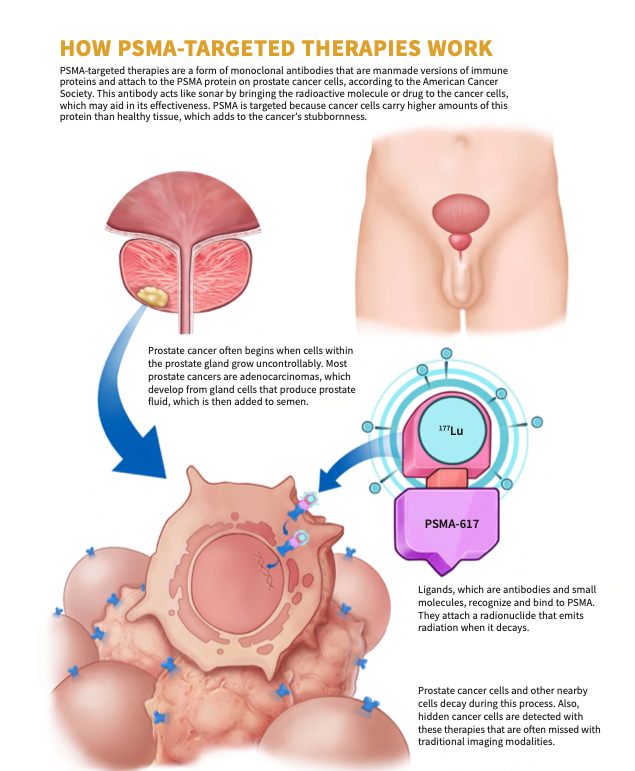Publication
Article
CURE
A Smart Bomb for Prostate Cancer
Author(s):
After decades of research, scientists inch closer to FDA approval for PSMA-targeted treatments that show promise for patients with an advanced form of prostate cancer.
In the fall of 2016, Dr. Mark DeAntonio learned he had a mass on his bladder. Doctors suspected stage 4 bladder cancer, and they confirmed the diagnosis with a biopsy. Over the next year, DeAntonio participated in two rounds of intensive chemotherapy, but the cancer didn’t regress — it spread. That’s when doctors referred him to the University of Southern California to participate in a clinical trial.
It turns out, DeAntonio didn’t have bladder cancer after all. “The tumor developed at the end of the prostate near the bladder, where it busted through the bladder wall,” says DeAntonio, now 67. “It was prostate cancer all along.”
Prostate cancer is the second most common cancer among men, affecting nearly 250,000 Americans annually. It happens most often when men have reached the height of their careers and are heading toward retirement — and it’s often highly treatable when diagnosed early. But for 10% to 20% of patients like DeAntonio, the disease can spread throughout the body and be remarkably resistant to treatment, especially the most common initial therapy used — androgen deprivation therapy (ADT). Called metastatic castration-resistant prostate cancer (mCRPC), these cancers grow and spread even in the absence of their preferred fuel: testosterone.
Dr. Mark DeAntonio received compassionate-use approval from the FDA for treatment with a particular PSMA-targeted therapy.

Since DeAntonio had already received chemotherapy for what he thought was bladder cancer, doctors prescribed ADT. These testosterone-blocking drugs controlled the cancer for several months, but within a year, DeAntonio’s PSA level began climbing again.
The cancer was growing.
He tried immunotherapy to stimulate his immune system to fight the cancer, followed by radiation to destroy the stubborn cells. Doctors even recommended surgery to remove his prostate and bladder.
DeAntonio resisted. The procedure wouldn’t change his prognosis, but it would severely compromise his quality of life. “The pain and stiffness in my pelvis was debilitating, and moving into noncurative treatments was scary,” DeAntonio says. “I was running out of options.”
A child and adolescent psychiatrist at the University of California in Los Angeles, DeAntonio ultimately received compassionate-use approval from the Food and Drug Administration (FDA) for six treatments with lutetium-Lu-177-PSMA-617 (177Lu-PSMA-617), a targeted treatment for prostate cancer. Used in Germany, Australia, India and parts of South Africa, 177Lu-PSMA-617 is part of a class of radioactive drugs that target a protein on the surface of prostate cancer cells called prostate-specific membrane antigen, or PSMA.
“PSMA is highly overexpressed in prostate cancer cells, whether they’re confined to the prostate or have metastasized to other sites,” says Dr. Jeremie Calais, an assistant professor of nuclear medicine and theranostics at the David Geffen School of Medicine at UCLA. “While some normal tissues express small amounts of PSMA, the PSMA-targeted radioactive agent preferentially attaches to cancerous cells, not the normal tissues.”
PSMA-targeted radionuclides are part of a new class of therapies known as theranostics, which offer both therapy and diagnostic capabilities. Scientists have developed ligands — antibodies and small molecules — that recognize and bind to PSMA. To this ligand, they attach a radionuclide that emits radiation when it decays. Depending on the choice of radionuclide, you get either a smart bomb that delivers molecularly targeted radiation directly to the target or a smart imaging tracer with less radiation that highlights PSMA-avid cells using standard positron emission tomography (PET ) imaging techniques. Add it all together, and a growing body of research both in the United States and abroad suggests that taking a PSMA-targeted approach could be a game changer for advanced prostate cancer.
A HISTORICAL LOOK AT PSMA
Dating back to the late 1980s and early 1990s, scientists were laser-focused on identifying tumor-specific targets that could help them distinguish cancerous cells from normal cells.
At the time, Dr. Neil Bander, now director of urological oncology research at Weill Cornell Medicine in New York, suspected that targeting PSMA could serve as a powerful weapon in the battle against prostate cancer — but researchers didn’t yet understand how to harness its potential.
Targeting PSMA diagnostically and therapeutically isn’t new. “The first PSMA imaging agent was approved more than 20 years ago,” says Dr. Scott Tagawa, medical director of the Genitourinary Oncology Research Program at Weill Cornell Medical College. Since then, researchers have been targeting PSMA in myriad ways from chemotherapy and antibody-drug conjugates to radionuclides, an approach that investigators expect to gain FDA approval in the coming months.
What makes PSMA unique? It’s consistently overexpressed in prostate cancer cells. PSMA should not be confused with PSA, a protein produced by cells of the prostate gland that may indicate prostate cancer at elevated levels. Normal prostate cells are also PSMA positive, but cancerous cells boast 100 to 1,000 times more PSMA than healthy tissue. The more stubborn and resistant to treatment the prostate cancer, the more PSMA on the surface of the cells. So if you target PSMA, you’re selectively targeting the cancer.
As luck would have it, one of the first-line treatments for prostate cancer — ADT — increases the load of PSMA on the surface of cancer cells. “PSMA levels are tightly linked to the androgen receptor pathway, and they increase as resistance to hormone therapy develops,” Tagawa says. So, in a sense, taking ADT is like using a homing beacon to detect an elusive target. Add a radioactive payload to the mix, and you have a veritable molecular grenade delivering cancer-obliterating radiation directly to hormone-resistant prostate cancer cells.
“Because of the radioactivity, we can confirm the therapy is reaching its target on imaging,” says Dr. A. Oliver Sartor, medical director of Tulane Cancer Center in New Orleans and a world-renowned prostate cancer researcher. “Radiation does not extend far beyond the cancer cell, so there is little damage to surrounding tissue.”
Because the radioactive isotope seeks out PSMA, just as a dog scours the floor for table scraps, the treatment can even find hidden cancerous cells that are too small to see on traditional imaging. The only hiccup: Not every patient with prostate cancer has easy-to-spot PSMA-expressing tumor cells circulating near tumors. Studies suggest that up to 10% of patients with metastatic, treatment-resistant prostate cancer have tumors that don’t light up on imaging.
The jury is out on whether patients who are PSMA negative or PSMA weak are less likely to respond to treatment. In addition, most patients with prostate cancer in the United States can’t access imaging with a PSMA-targeted agent — at least not yet.
TRAVELING FOR TREATMENT
For the past several years, researchers in the United States have been testing PSMA-targeted treatments, specifically 177Lu-PSMA-617, in patients with mCRPC that didn’t respond to prior therapies. They have demonstrated that 95% of prostate cancers are PSMA positive and that PSMA spikes in response to ADT. They even have high-powered imaging that shows the treatment is reaching its target. Yet the FDA has not approved PSMA-targeted agents for the treatment of prostate cancer. And until recently, PSMA imaging was only available at two sites in California (UCLA and UCSF), or as part of a clinical trial.
Dr. Mark DeAntonio avoided serious complications while undergoing treatment.

But that tide is about to change. Earlier this year, the FDA approved another PSMA PET imaging agent that will make PSMA PET imaging available throughout the United States. More importantly, for therapy, the FDA granted breakthrough therapy designation to 177Lu-PSMA-617 after a phase 3 clinical trial showed improvements in survival among patients with mCRPC. For the trial, Sartor and his colleagues enrolled more than 800 patients with mCRPC that had disease progression on other treatments and a positive PSMA PET scan. Trial participants randomized to the 177Lu-PSMA- 617 group were 40% less likely to die and 60% less likely to show disease progression on imaging versus those who received standard of care alone.
“Many of these patients were on their fourth-, fifth- and sixth-line treatments,” says Sartor. “The more treatments a patient receives, the more resistant they are to the next line of therapy, so if we can show activity in patients who have already been treated with multiple lines of therapy, we anticipate the response will be even better in patients who are treatment naive.”
While these targeted treatments await approval, patients like 66-year-old Steve G.* are getting creative. Steve had a prostatectomy in 2015, but because he hadn’t received chemotherapy, he wasn’t eligible for PSMA-targeted trials in the United States. A computer scientist, Steve made it his mission to learn everything he could about prostate cancer — and he wasn’t opposed to hopping around the globe to get the best care. “It’s in my DNA,” Steve jokes.
In the early ’80s, the surgeon who pioneered nerve-sparing prostatectomies, Dr. Patrick Walsh, operated on Steve’s father at Johns Hopkins Medicine. “That set the precedent for me,” says Steve, who ventured to New York to see the top surgeons and oncologists in the country, then to UCLA to get a PSMA PET scan and finally to Germany — five times — so doctors could inject him with 177Lu-PSMA-617.
“The ‘compassionate use’ program in Germany allows for the use of untested therapies in patients who have exhausted all approved treatment options,” Sartor says. But German investigators only treat patients whose PSMA PET scans light up like a neon sign that reads “targetable cancer cells HERE!” With this carefully curated population, they’re able to achieve striking response rates.
So if patients are willing to take the risk — and can afford multiple trips to Germany — they can access promising, but unproven, treatments outside a formal clinical trial. In fact, the growing number of American patients who make that trek are adding to the repository of data showing that targeted radionuclides could provide hope, and even durable remissions, in patients with mCRPC.
Steve says the experience of receiving 177Lu-PSMA-617 in Germany is both similar and different than in the United States. Staff ensure that they have paid upfront. Then they give patients the traditional hospital wristband before directing them to the nuclear medicine ward. “The facility in Munich is like a labyrinth of old buildings connected by walkways,” Steve says. “You travel the hallways walking on solid ground and then shift to walking on wood. It’s quite quaint.”
*Last name omitted for anonymity.
How PSMA-targeted therapies work.

Against a backdrop of gray walls and dim lighting, staff insert an IV to draw blood for testing and then flood the patient’s system with fluids. The additional fluid coaxes their body to excrete any radiation that isn’t attached to the cancer. Steve had an IV dripping for more than an hour before the five-minute infusion.
“When it’s time for (177Lu-PSMA-617), the technician turns on the pump and practically runs out the door,” Steve says. “You have to quarantine for a minimum of three days before they release you back into the world in order to comply with strict emission standards in Germany.”
177Lu-PSMA-617 has a half-life of around a week, so patients emit measurable amounts of radiation for weeks after the treatment.
After Steve received five treatments, two of which took place at the height of the COVID-19 pandemic, his PSA level had become undetectable by various assays — and it has remained undetectable ever since. His last PSMA PET scan at UCLA revealed that his cancer has almost disappeared, although a few slightly PSMA-positive lymph nodes remain.
THE ALPHAS, BETAS AND GAMMAS OF PSMA
Radioisotopes are unstable chemical elements that release radioactive particles. They destroy cancer by damaging its DNA. Different elements release different types of particles, such as alpha or beta, and each behaves in distinct ways.
Isotopes such as actinium 225 and radium 223 emit alpha particles when they decay. These high-energy particles have a very short range and obliterate everything in their path. Beta particles, such as those emitted by 177Lu-PSMA-617, have 2,000 to 4,000 times less energy, depending on the alpha, but travel farther, setting up crossfire in a PSMA-avid tumor. The isotope lutetium 177 has the bonus of emitting a small percentage of gamma rays when it decays, which makes it detectable for imaging. So if alpha-emitting particles are like precisely delivered atomic bombs, lutetium 177 is a radioactive hand grenade with GPS tracking.
In a case study published in Acta Radiologica Open, one patient who had significant disease progression on multiple lines of treatment had experienced dramatic results with a PSMA molecule carrying actinium 225. The “before and after” images revealed that the widespread metastatic cancer had completely disappeared. And the patient’s PSA levels plummeted from the hundreds and thousands to undetectable.
Unfortunately, it’s tough to produce spectacular results like that without some collateral damage. “An alpha particle in the right spot is so powerful it will destroy the target on contact,” Tagawa says. “The problem is an alpha in the wrong spot can produce permanent damage.”
Historically, scientists have shied away from small molecules because they can readily target normal tissues that express low levels of PSMA, such as the salivary and lacrimal glands. That can lead to dry mouth and dry eye. “Beta particles emitted by (177Lu-PSMA-617) trigger only mild toxicities that are usually reversible. But alpha particles can permanently destroy the salivary glands, and that’s not a small problem,” says Calais, explaining that without salivary glands, patients cannot taste or eat, and, over time, teeth fall out.
And because the radioisotope is excreted through the kidneys and bladder, there’s a risk of kidney toxicity, particularly with the alpha-emitting isotopes. Decreased blood counts may also occur because of effects on the bone marrow. Such serious and often irreversible toxicities with alpha-emitting particles are one reason why beta particles are leading the charge in the United States. Tagawa knows of only four prospective studies using PSMA-targeted alpha particles, and three of the four use antibodies, not small molecules (antibodies are too large to reach those unintended targets).
Fortunately, DeAntonio and Steve both sidestepped serious complications. But even with only 177Lu-PSMA-617, Steve developed dry mouth after his fourth treatment and DeAntonio had a horrible inflammatory reaction after his first injection. “It felt like I had a bad flu along with tremendous pelvic pain. The reaction went away after five days, but two weeks before my second treatment, the pain came back,” DeAntonio says.
There isn’t enough experience with this treatment to know whether the inflammatory response is a good sign.
DeAntonio’s PSA level was also higher after treatment. “If you base my response on lab studies, there has been no improvement in my disease state, but clinically, I’m better,” says DeAntonio, who is just about to meet his first grandchild.
For DeAntonio and many other patients with mCRPC, the focus is on the horizon. A whole new class of drugs is emerging for prostate cancer. The idea is to keep the cancer at bay and extend patients’ lives long enough to take advantage of new treatment options.
“I’m not expecting a cure,” says DeAntonio, “but I have no interest in dying.”
LOOKING FORWARD
Emerging data suggest that combining both alpha- and beta-emitting particles may improve outcomes for patients with advanced castrate-resistant prostate cancer (CRPC) and minimize toxicity. Investigators expect radionuclides that target prostate-specific membrane antigen to become standard of care for CRPC in the not-so-distant future. Over time, and perhaps with more refinements, it may even become an earlier-line therapy for patients who recently received a diagnosis.
For more news on cancer updates, research and education, don’t forget to subscribe to CURE®’s newsletters here.





